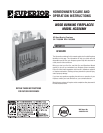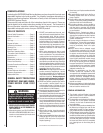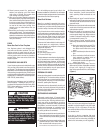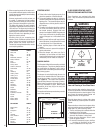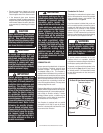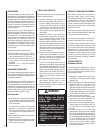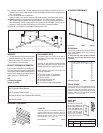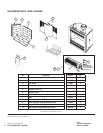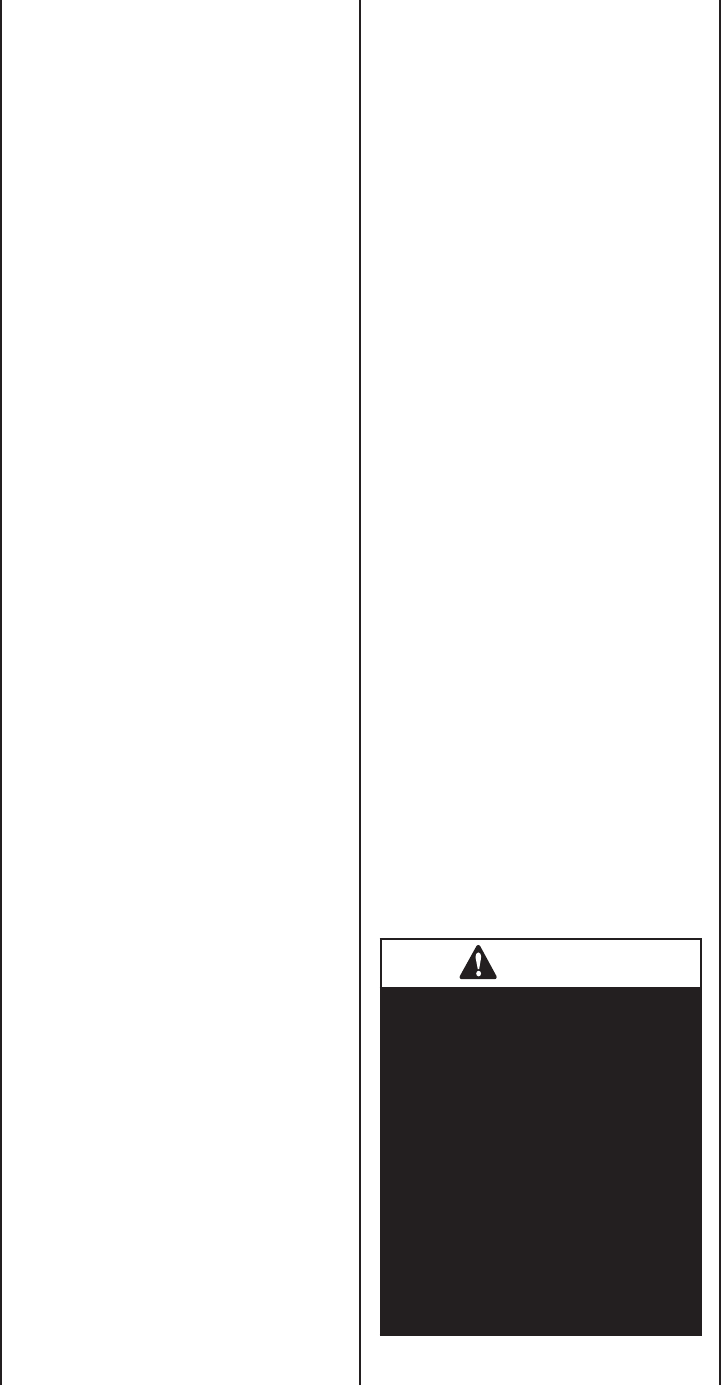
6
NOTE: DIAGRAMS & ILLUSTRATIONS ARE NOT TO SCALE.
REFRACTORIES
All fi reboxes contain a furnace refractory fl oor,
sides and back. These refractories are reinforced
with steel, but can be broken by improper use.
Dropping logs on the bottom refractory and
building fi res directly against the refractories
can cause premature burnout of these com-
ponents. It may easily be repaired or replaced
at costs far below repair and maintenance for
masonry fi replaces.
Proper care and “burn-in” of the fi rebox will
prolong the period of enjoyment without ex-
tensive maintenance. For the fi rst few uses,
build small fi res – not roaring infernos. The
materials used in the refractories contain and
absorb moisture. It is important to “cure” the
refractories by building only modest fi res. Under
normal usage, it is expected that hairline cracks
will appear in the refractory surface. These
hairline cracks do not affect the safe operation
of the fi replace.
Refractories should be replaced when:
1. The crack opens more than 1/4" (19 mm).
2. Pitting in the surface is extensive and pits
become deeper than 3/16" (4.76 mm).
3. Any piece of refractory larger than 2" (51
mm) in radius and 3/16" deep becomes
dislodged.
If conditions 1, 2 or 3 occur, the refractory
should be replaced.
MAINTENANCE GUIDELINES
Your fi replace is designed to operate trouble-free
with minimum maintenance. However, like any
fi ne appliance, it deserves and requires some
housekeeping attention.
Your fi replace will perform better – and certainly
look more attractive to family and friends – if
it is cleaned before each use. Before the fi rst
seasonal use in Autumn and after the last fi re
in Spring, it is important to inspect the fi replace
system carefully. We recommend at least two
complete fi replace inspections a year.
Before Each Use
1. Clean the fi rebox of excessive ashes. Some
owners prefer to leave a small layer to insulate
the cold refractory below the grate which
helps fi re starting.
This fi replace has a factory supplied grate
attached, it is permissible to remove the
grate for cleaning; however, the grate must
be re-attached to the fi replace before the
next burn.
2. Keep the fi replace screens clean so combus-
tion air fl ows freely.
3. Spot check the brick-like refractory for small
cracks. Heat from the fi re expands it slightly.
When it cools, it contracts.
TWICE A YEAR CHECK-UP
Normally, twice a year, you should inspect your
fi replace following this list:
1. Inspect the opening in your chimney top
and remove any debris that could clog it.
The cap is usually held in place by four (4)
screws, which remove easily for checking
or cleaning the full length of the fl ue from
above. Remove the chimney top while
wearing gloves to guard against any sharp
metal edges.
2. Inspect the entire fl ue from the top down
for obstructions such as birds nests, leaves,
etc. This may be done by using a fl exible
handled chimney cleaning brush. If the
chimney contains offset/return elbows; a
soft brush cleaning from the top down to any
elbow and then from the fi rebox up to the
offset/return section is the proper method.
The beam from a powerful fl ashlight will
help in this inspection.
3. Look up from inside the fi replace (damper
open) to see any obstructions in the lower
fl ue area. If present, shut the damper and
glass doors (if installed) to seal the fi rebox
and contain any soot that might fall.
If your do not have glass doors installed, a
damp sheet covering the fi replace opening
and sealed with masking tape will do. Then
clean the fl ue from the top down (if an offset
system, clean per Step 2) using a proper size
chimney brush with fl exible pole sections.
Don’t open the doors or remove the sheet
until all soot has settled. Vacuum, don’t
sweep.
4. Check the metal fl ashing and seals around
your chimney. Seal any cracks or loose
nailhead openings to prevent roof leaks.
5. Clean the fi rebox thoroughly by using a soft
brush or equivalent.
CREOSOTE FORMATION AND REMOVAL
When wood is burned slowly, it produces tar
and other organic vapors, which combine
with expelled moisture to form creosote. The
creosote vapors condense in the relatively
cool chimney fl ue of a slow-burning fi re. As
a result, creosote residue accumulates on the
fl ue lining. When ignited, this creosote makes
an extremely hot fi re.
The chimney should be inspected at least twice
yearly during the heating season to determine
if a creosote build-up has occurred.
If creosote has accumulated, it should be re-
moved to reduce the risk of a chimney fi re.
If creosote build-up is found, do not use chemi-
cal chimney cleaners that are poured on a hot
fi re. The chemical cleaners can be dangerous
and generally only work on the fl ue section
nearest the fi re, leaving the rest of the fl ue
unaffected. It is best to take the time to clean
the fl ue as previously described or have the
chimney professionally cleaned by a qualifi ed
chimney sweep.
TROUBLESHOOTING
No Smoking Allowed
Your new fi replace is designed not to smoke if
properly installed and operated per our instruc-
tions. If you do experience a problem, here are
several things to check:
1. Remember – always check to ensure your
fl ue damper is in the open position before
lighting a fi re!
2. When lighting your fi re, a little smoke may
escape into the room – more likely if the
chimney is cold. To correct this, hold a
lighted newspaper up inside the fi rebox near
the open fl ue damper. This will turn around
any downdraft and clear the fl ue of cold air.
As your log fi re burns below, the updraft will
improve as the chimney heats up.
3. Is your fi re too far forward? Move it toward
the back with your poker. Keep the fi re well
within the confi nes of your fuel grate.
4. Keep your fi re up on the grate and the re-
fractory below free of excessive ashes. The
fi re needs plenty of air movement around
the logs.
5. If smoking occurs an hour or two after
lighting the fi re, perhaps your well-insulated
house is too airtight and there is scarcely any
way for replacement air to enter and feed the
fi re. Check to see if your outside combustion
air kit (if installed) is open. Check outside
to ensure no obstructions are in front of
exterior air entry. Open a window slightly,
open doors to one or two rooms and see if
this stops the smoking.
WARNING
Continued overfi ring can perma-
nently damage your fi replace
system. Some examples of
overfi ring are:
• Burning quantities of scrap
lumber, pine branches, paper
or cardboard boxes which ex-
ceed the volume of the normal
log fi re.
• Burning trash, chemicals or
chemically treated combus-
tibles.



